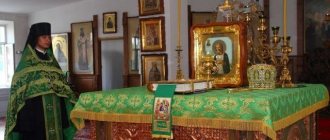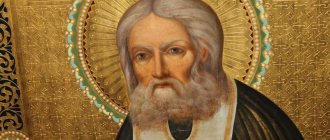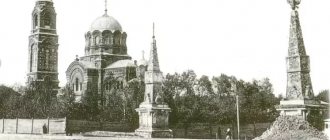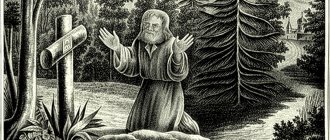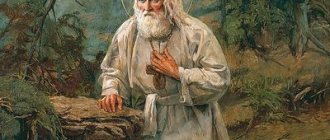Recommended for publication by the Publishing Council of the Russian Orthodox Church (IS 14-402-0180)
© Blagovest Publishing House – text, design, original layout, 2014
All rights reserved. No part of the electronic version of this book may be reproduced in any form or by any means, including posting on the Internet or corporate networks, for private or public use without the written permission of the copyright owner.
* * *
Life of the Wonderworker Seraphim of Sarov
The life of St. Seraphim of Sarov has earned the national veneration and love of the Orthodox people: he is always close to our souls and invisibly remains with us in suffering, sorrow, and trials.
Therefore, you cannot find a temple in Russia where the face of Seraphim does not reside on the iconostasis.
Lives of other Orthodox saints:
- Life and biography of Alexander Nevsky
- Life and biography of Stefan of Perm
- Life of the Holy Venerable Kuksha of Odessa
Icon of Seraphim of Sarov
Infancy
The baby Prokhor came into the Light of God in 1754. His father served as a merchant and was involved in the construction of buildings. At the end of his life, he decided to build a cathedral, but did not live to see the completion of the construction. The boy remained with his mother, she raised him and instilled in the child a deep faith in Christ.
After the death of her husband, the widow continued the construction of the cathedral. One day she took Prokhor with her to a construction site. But he unexpectedly stumbled and fell from a high bell tower. The mother rushed down and found her child safe and sound. Thus, the Creator Himself preserved the life and health of His future lamp.
Prokhor had an excellent memory and science was easy for him. The teenager loved to attend services and read Lives and the Gospel to his friends. One day the boy became seriously ill, and doctors could not find a medicine to cure him. But in a dream vision, the Mother of God promised to cure a serious illness. Soon a religious procession with the “Sign” icon took place at the family estate.
The mother carried the sick man out and placed him on the Face of the Virgin Mary, after which the boy quickly recovered.
Beginning to Serve the Lord
From a young age, Prokhor dreamed of dedicating his life to the Savior and entering a monastery. The mother did not interfere with her son’s will and blessed him for monasticism with a crucifix. The saint wore this cross on his chest all his life.
Once Prokhor, as part of the pilgrims, went on foot from Kursk to Kyiv to worship the Pechersk saints. There he decided to flee to the Sarov desert. Returning to his father’s house, Prokhor said goodbye to his mother forever and went to Sarov. The abbot kindly received the God-loving young man and appointed him a confessor, under whose leadership the future saint performed his obediences.
The young man was a cell attendant, worked in a bakery, a prosphora bakery, worked as a carpenter, and was a sexton. He performed any type of work with special zeal.
A couple of years later, Prokhor fell ill with dropsy, his body became very swollen, he was in great pain and difficulty. He was looked after both by his mentor and by those monks who loved the kind and hardworking young man. The illness plagued his body for about three years, but none of those around him heard a drop of grumbling from Prokhor. The elders wanted to call a doctor to see him. But Prokhor strictly forbade them to do this; he wanted only one thing - a speedy Communion.
Then a vision happened: the Most Holy Mother of God appeared in the Divine Light and touched the patient’s side with a rod - immediately the liquid, which was in abundance in Prochorus’ body, began to flow out through the resulting hole. The young man quickly recovered.
Pavel Ryzhenko “Seraphim of Sarov”
tonsure
Prokhor lived as a novice in the monastery for 8 years, after which he was honored to accept monasticism. In his tonsure he was given the name Seraphim. A year later, observing the young monk’s fiery love for the Lord, the abbot decided to elevate Seraphim to the rank of hierodeacon.
The monk served in the temple every day, and after the service he prayed incessantly.
The zealous service of the monk was rewarded by the Almighty: Seraphim was granted visions of grace during the services. He repeatedly contemplated the heavenly Angels who co-served the monastery brethren.
And one day during the service, when the abbot pointed the orar at the prayer books, a golden ray overshadowed him. Seraphim looked up and saw the Savior Himself, He walked from the temple doors, accompanied by the Ethereal Heavenly Forces. The monk froze with admiration and delight; he could not even move from his place.
After the miraculous vision, Seraphim began to be more zealous about his service: during the day he worked as hard as he could in the monastery, and at night he left his native walls and went into the forest to pray.
era
The time when Rev. lived. Seraphim (1759-1833) is a very difficult period in the history of Russian spirituality and Russian monasticism. Rev. Seraphim is the same age as the monastic reform of Catherine the Great - the introduction of monastic "states" and the confiscation of church lands. The reform was carried out in 1764. Rev. Seraphim (however, at that time he was still just a boy, Prosha, Prokhor Moshnin) was then 5 years old. He grows against the backdrop of these events.
Catherine was not some evil enemy trying to destroy everything in the Church. She was truly a great empress. The contemporaries of Peter I and Catherine II were not far from the truth when they criticized the contemporary state of monasticism. Hand on heart, what can we remember who was outstanding from the history of Russian monasticism and Russian holiness, say, in the second half of the 17th century, in the pre-Petrine era? Almost nothing. The most striking events are associated with the schism, with the confrontation between Nikon and Avvakum. That is, all the people’s energy, all the spiritual potential went into schism, negativity, into the poetry of schismatic monasteries, later sung by Melnikov-Pechersky and Leskov. What remains “positive”? A huge number of shortcomings, errors and simply outrages, which throughout the second half of the 17th century and the first half of the 18th century, both church and secular authorities tried to eradicate.
Look at the Acts of the Councils of 1667, 1682, numerous decrees of Tsar Alexei Mikhailovich, Tsar Peter the Great, aimed at eradicating drunkenness, parasitism, vagrancy in monasticism, and instilling national discipline. Control appeared - yes, unnecessary, excessive control - but, nevertheless, control by the state. The bishops were required to maintain order in monastic life, they demanded order from the abbots, and something changed.
A few words about secularization, in fact the nationalization of monastic properties. The state could no longer tolerate that a whole million of its subjects were in serfdom from the monasteries and that such a large percentage of the land remained with the monasteries. By Catherine's reform, monasticism was freed from the need to run a huge economy: the Trinity-Sergius Lavra, for example, had one hundred thousand serfs, and its possessions were located in seven or eight provinces! We were suddenly freed from all of this. And where should the energy go? To an inner monastic revival! From now on (although this is not at all a “discovery” of the 18th century, but the original essence of monasticism), the “leading edge” of monasticism - holiness - passes through the heart of every monk.
Yes, of course, not everyone was capable of this, not everyone was ready. But still, a revival began slowly. Revival on new terms. What are these new conditions? What is new about the situation? Almost for the first time, the era of Peter and Catherine introduced monasticism into the sphere of theological thought.
The Russian clergy (with the exception of several figures of Little Russian origin), the Russian Church, accepted this monastic reform with humility. The only way of internal protest on the part of the Russian clergy and Russian monasticism was... asceticism. Both under Catherine and after, in Soviet times: the harsher the pressure and stronger the oppression, the harsher the anti-church terror became, the more ascetics, the more saints appeared on Russian soil...
Feat of desert living
At the age of 39, the monk was elevated to the rank of hieromonk and was blessed to conduct the Divine Liturgy. When the abbot of the monastery departed to the Lord, Seraphim took upon himself the feat of living in the desert (the late Father Pachomius blessed the monk before his death). Having received another blessing from the new abbot, he retired into the deep forest.
But he did not completely abandon the monastery; every Saturday evening, before the start of the all-night vigil, he returned to the monastery and received the Holy Mysteries of Christ.
The exploits of Seraphim, which he performed in the Name of Christ, were severe:
- his prayer rule was carried out according to the Rule of the ancient desert dwellers;
- he constantly studied the Holy Gospel, the New Testament, diligently studied liturgical literature;
- the monk knew many chants by heart, and when he worked in the forest, he loved to hum them;
- he got food for himself, worked in the garden;
- He kept a strict fast, ate only once a day, and went hungry on fasting days of the week.
His meager diet during the first three years of hermitage consisted of herbs. Occasionally he was visited by the same hermits.
The rumor about the solitary life of the priest spread beyond the monastery and monks and laymen began to visit him often. Each person needed wise advice, answers to questions and blessings for their work. Soon Seraphim forbade women from visiting his cell, and then everyone else, because in another vision the monk saw that the Lord desired the monk’s complete silence.
The saint’s social circle narrowed; now only wild animals and birds could visit him. Seraphim loved to feed wild bears with bread, which was delivered to him from the monastery bakery.
Icon of Seraphim of Sarov
Temptations of the devil
The monk's lofty exploits aroused the disapproval of the devil. He decided to frighten the saint so that he would remain silent. The monk did not succumb to the attacks of dark forces, but Satan stubbornly continued the temptation. But Seraphim, in order to repel the onslaught of the enemy, took on the feat of pillar-bearing for 1000 days.
But disgraced by the saint’s faith, the devil decided to kill the saint and sent robbers to him, who began to demand money from him. Naturally, he had no money, for which the robbers brutally beat the monk and broke his head with an ax. The saint lay in a lifeless state until the morning, and when he woke up, with the last of his strength he made his way to the monastery. The brethren were horrified by the sight of the wounded ascetic. For eight days, the monastery doctors pulled Seraphim “from the other world,” because the wounds he received were incompatible with life.
But the healing did not come from doctors. The Queen of Heaven appeared to him in a dream and, touching his wounded forehead, gave him health. But the monk’s back remained hunched, so he had to walk leaning on his staff.
The monk spent about six months in the monastery, and having gained strength, he returned to his forest cell. He spent three years in silence. Seraphim was asked by the abbot and the brethren of the monastery: to attend services and receive communion, or to return to the monastery. Seraphim chose the second because, due to his injury and advanced years, it was difficult for him to walk from the forest, in which he accomplished the feat of living in the desert for 15 years, to the monastery.
The end of the earthly journey
Returning, he added a shutter to the feat of silence. The monk did not leave his cell and did not receive anyone.
For his labors, he was honored by the Lord with the gift of working miracles and was assigned to serve people in the feat of old age. The Mother of God herself appeared in a dream to Seraphim and commanded him to come out of seclusion in order to receive petitioners asking for guidance, consolation, and healing.
Now the door of the elder’s cell was open to everyone! The miracle worker contemplated human hearts, healed parishioners with prayer, and consoled them with kind words.
In the last years of his life, Seraphim took special care of the Diveyevo monastery, which was his brainchild. He was a kind father to the sisters of the monastery, looked after the monastery, and the sisters turned to the elder in all difficulties.
A year before his death, Father Seraphim became very weak and made a coffin for himself. He showed the monks the place where his body should be buried. On January 1, 1833, the elder took communion for the last time, after which he blessed the brethren and gave good wishes to each monk, and the next day he reposed in the Lord.
His body was found lifeless before the Face of the Mother of God.
During illness in adolescence
“Philokalia”: between church and culture
The 18th century, on the one hand, opened a window to Europe, and Russia was literally overwhelmed and crushed by the European Enlightenment. This process is often seen - and rightly so! - a lot of negative things. In fact, there were a lot of good things. Science was needed, and our great Lomonosov was able to transform and synthesize European science into Russian science. And create the first Russian University with Shuvalov. Princess Dashkova, with the blessing of Catherine, creates the Russian Academy of Literature and the Dictionary of the Russian Academy. There is nothing bad in enlightenment as such - as long as it does not become an eclipse, it was necessary. Even for monasticism: without this, the Philokalia would not have appeared in Russian spiritual culture. What it is? Rev. Seraphim was a younger contemporary of the Monk Paisius (Velichkovsky), a younger contemporary of Metropolitan Gabriel (Petrov), who are doing a very great job. The first, first on Mount Athos, then in his Moldavian monasteries, collects and translates ancient patristic teachings into Russian, creates the so-called “Philokalia” - a large collection of works by ascetic monks of the past, which are spiritual classics. The second blesses this publication and heads it. Thus, the monks receive a textbook, a kind of ascetic encyclopedia. All the Philokalia are steps to prayer. What is prayer? Why is prayer needed at all? Rev. Seraphim, not only in a well-known conversation with his disciple Motovilov, but also with the example of his entire life, answered this question: prayer, just like reading the Holy Scriptures, just like theological reflection, just like participation in the Liturgy - all this is just MEANS for acquiring the grace of the Holy Spirit. That is, prayer and the Philokalia open a new path for a person...
So, the “Philokalia” arises when a monk becomes—can, if necessary, become! - a philologist, textual critic, knows languages and can translate from Greek and, if something is not preserved in Greek, take it from Latin translations and compare it with texts in other languages. If we open the Dictionary of the Russian Academy, we will see that its main authors were clergy. And the aforementioned Metropolitan Gabriel (Petrov) blessed and headed the publication.
In fact, monasticism and the Church in general cannot exist without culture. This is the eternal contradiction between the Empire and the Desert, between the Church and Culture. Does the Church need culture? A hesychast monk who performs the silent, self-propelled Jesus Prayer does not need anything: neither Moscow, nor St. Petersburg, nor Mount Athos, nor Jerusalem with its shrines. He doesn't even need books. But, on the other hand, if we all say that we don’t need anything, then we will have neither the Trinity-Sergius Lavra, nor the Sarov Monastery, nor the Cathedral of Christ the Savior. In relation to the Church and culture, the dialectic is much more subtle than it sometimes seems to some. “The Philokalia” is impossible without high culture, and without the Philokalia, just as without St. Seraphim, true spirituality is impossible. Moreover: without the Philokalia, St. Seraphim himself is impossible.
So, what happened in the second half of the 18th century? Two lines of development - the line of spiritual, theological enlightenment and the line of ascetic achievement - met, collided, then somehow synthesized and something happened. What are these lines and what happened? On the one hand, there is the path of the European Enlightenment. It, as I already said, was necessary from all points of view: both for the monks, and in order for our magnificent theological science to arise, and the system of four academies, seminaries in each diocese, etc. On the other hand, there was another reserved the path is the inner spiritual dispensation.
Holy relics
70 years after the death of the God-bearing elder, people came to his grave for consolation in sorrows, help and healing from illnesses. The saint had not yet been canonized, but thrones were already being prepared in his honor, a life and prayers were being compiled, and icons were being painted. And only in 1903, Elder Hieromonk Seraphim was canonized.
On his birthday (July 19), the discovery of his honest relics took place. After the revolution they disappeared.
Their second discovery took place only in 1991 in St. Petersburg, after which they were taken in a religious procession to the Trinity Seraphim-Diveevsky Monastery.
About prophecies, real and imaginary
There is a lot of talk today about the prophecies of St. Seraphim. Even if he had not left any verbal prophecies - in the literal, everyday sense of the word, his very feat, his service for Russia turned out to be prophetic. Russia saw in him a new path, the possibility of life in the Holy Spirit.
As for the words and texts directly that are attributed with greater or less certainty to St. Seraphim, I will first allow myself a general methodological remark. Just as holiness is always on the verge of delusion, in the same way the Orthodox faith is almost always on the verge of superstition. Therefore, the attitude towards prophecies and any texts attributed to one person or another, not only St. Seraphim, is each time a very subtle and serious question. Here we ourselves easily fall into a certain delusion, seeking and desiring at any cost some prophecies.
I have already said that there is an autograph of St. Seraphim: he recommends everyone to read the Philokalia.
There are no other autographs of St. Seraphim, for example, with the texts of prophecies that are often talked about. All the main texts that are associated with the so-called prophecies appeared from somewhere in some grandmother’s chests, some archives.
All this appeared at the beginning of the twentieth century. On the one hand, the radiance of the personality and significance of St. Seraphim flared up brightly. And immediately around him swirled, as usually happens, earthly lights, reflections, flashes, also fiery in their own way, with apocalypticism and prophecies. These prophecies, at least those that I have read, are not always similar to St. Seraphim. Prophecies, real prophecies as a type of spiritual vision, are not characterized by specific instructions - about “noble conspiracies”, “revolutions”, especially about the future of the monarchy. In the prophecies attributed to St. Seraphim, a different era is too clear.
All of them passed through the hands and censorship of Nikolai Aleksandrovich Motovilov, Sergei Aleksandrovich Nilus and Pavel Aleksandrovich Florensky. Everyone refers to the fact that these are supposedly from Motovilov’s archives, everyone refers to the fact that Nilus was the first to find and rewrite them, and many refer to the fact that they exist, rewritten by the hand of Pavel Florensky. With all due respect to this, and the other, and the third, they are all people of a later time.
Leave me the Monk Seraphim with his “Philokalia” in his knapsack, with his near and far desert, with his herb snitka, with his real prophetic ministry. Because he showed the way - how to live and how to perform spiritual work. And there are no paths to revolution or counter-revolution, or understanding of what will happen next - the split of renovationism, the retreat of the hierarchy, and so on. — didn’t indicate any of this.
... Let's say that I am wrong and among these prophecies there are several that come directly from St. Seraphim. Do they add much to his greatness? Let's ask such a simple question, a church-liturgical one. They don’t add anything, they just introduce some kind of dregs. Suddenly mixed with the completely complete image of St. Seraphim are some discussions about the French Revolution, about our Russian Revolution and about the fate of the monarchy, and about the fate of the hierarchy, about the great retreat and then about the return of Russia to the fold of Orthodoxy. The Monk Seraphim does not need this.
View of the Sarov Desert from the southwestern side. Lithography. Etching. 1853
Miracles
Many miracles are associated with the name of the great elder. Through prayers to Blessed Seraphim, the dumb found their voices, the blind saw their eyes, the crippled were freed from lameness, and the paralyzed could move their limbs.
- The 19-year-old girl had cramped limbs, her hands were tightly clenched on her chest. After visiting the grave of Seraphim and bathing in the spring consecrated in the name of the God-bearer, the patient stood up independently, her arms and legs straightened, and she began to move independently.
- The peasant woman was paralyzed 6 years ago. She, immobilized, was brought to the spring and dipped in it three times. The woman was completely healed.
- A mother and her deaf-mute daughter took part in the procession. At the front of the procession, banner bearers carried the Face of the Virgin Mary and a large icon of Seraphim of Sarov. The woman placed the child next to the image of the saint and the baby immediately called out to her mother in her voice.
- At the grave of the miracle worker, a young woman who had completely lost her sight several years ago regained her sight.
There are cases where people were healed from insanity, paralysis, oncology and other serious illnesses. All facts of healings are recorded in the Chronicle of the monastery.
Necessary Preface
It is very difficult to talk, write about saints, or make films about them. It’s difficult, firstly, because the tradition in which holiness was—could have been—was destroyed long ago! - direct experience of the life of a Russian person. Moreover, this break did not occur seventy or eighty years ago, during the times of Soviet atheism, but much earlier. Already in the era of Rev. Not everyone understood Seraphim and accepted those people who were later glorified as saints.
Secondly, in our Church there is almost no theological teaching on holiness. As Vasily Vasilyevich Bolotov, the great church historian, said, the Orthodox Church has a well-developed doctrine of the Holy Trinity, of Christ, and little of anthropology, that is, the doctrine of man. And the doctrine of holiness is directly related to Christian anthropology, since holiness is the highest state of a person in his possible approach to deification.
Photo by Vyacheslav Lagutkin
There is one more subtlety. Within the Church itself, holiness has always been treated with some caution. For a very clear reason: because she is on the knife’s edge with delusion, that is, a false spiritual state, a pseudo-spiritual experience. Sometimes it is very difficult to discern where and how the state of holiness turns into a state of delusion. As one poet said: “...my days run evil, they spin in a circle, I live on the edge of glory, like on the edge of a knife.” So, on the verge of glory, glory not in the everyday sense, but in the sense of church glorification, the radiance of an icon halo - this is always on the edge of a knife. Therefore, let’s not consider it strange that the Rev. Some of his contemporaries and his monastery authorities were wary of Seraphim, his exploits and miracles.
Veneration of the Reverend
The Wonderworker has been deeply revered among Christians for many centuries, and therefore you can worship him in any church of the Russian Orthodox Church.
Memorial Days
St. Seraphim is commemorated several times:
- January 15;
- 27th of June;
- August 1;
- 10th of August;
- on the day of the Council of Nizhny Novgorod Saints.
Often, icon painters depict the monk as a gray-bearded old man
Iconography
Often, icon painters depict the monk as a gray-bearded old man, standing up to his waist or at full height. He wears simple black clothes, and a halo shines above his head. The saint holds the cross with his left hand and blesses with his right hand. One of these images is located in the Holy Trinity St. Sergius Lavra. There are also icons depicting scenes from the life of the miracle worker.
Future
I don't know if Russia has a future. And the Monk Seraphim did not say. Ultimately it is still up to us. God gave us everything! He gave great Russia, he gave us our parents, grandparents, who preserved this Russia for us, he gave us the great saint of God Seraphim and thousands of holy ascetics, confessors and new martyrs, who in different types of service showed us how to live and what to be. We have everything. The rest depends only on ourselves.
And therefore today we turn again to the image of St. Seraphim...
